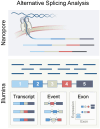Alternative splicing of modulatory immune receptors in T lymphocytes: a newly identified and targetable mechanism for anticancer immunotherapy
- PMID: 39845971
- PMCID: PMC11752881
- DOI: 10.3389/fimmu.2024.1490035
Alternative splicing of modulatory immune receptors in T lymphocytes: a newly identified and targetable mechanism for anticancer immunotherapy
Abstract
Alternative splicing (AS) is a mechanism that generates translational diversity within a genome. Equally important is the dynamic adaptability of the splicing machinery, which can give preference to one isoform over others encoded by a single gene. These isoform preferences change in response to the cell's state and function. Particularly significant is the impact of physiological alternative splicing in T lymphocytes, where specific isoforms can enhance or reduce the cells' reactivity to stimuli. This process makes splicing isoforms defining features of cell states, exemplified by CD45 splice isoforms, which characterize the transition from naïve to memory states. Two developments have accelerated the use of AS dynamics for therapeutic interventions: advancements in long-read RNA sequencing and progress in nucleic acid chemical modifications. Improved oligonucleotide stability has enabled their use in directing splicing to specific sites or modifying sequences to enhance or silence particular splicing events. This review highlights immune regulatory splicing patterns with potential significance for enhancing anticancer immunotherapy.
Keywords: T lymphocytes; alternative splicing; cancer; immune receptors; immunotherapy.
Copyright © 2025 Tzaban, Stern, Zisman, Eisenberg, Klein, Frankenburg and Lotem.
Conflict of interest statement
The authors declare that the research was conducted in the absence of any commercial or financial relationships that could be construed as a potential conflict of interest.
Figures







Similar articles
-
Alternative splicing: A key regulator in T cell response and cancer immunotherapy.Pharmacol Res. 2025 May;215:107713. doi: 10.1016/j.phrs.2025.107713. Epub 2025 Mar 25. Pharmacol Res. 2025. PMID: 40147681 Review.
-
Dynamic nanopore long-read sequencing analysis of HIV-1 splicing events during the early steps of infection.Retrovirology. 2020 Aug 17;17(1):25. doi: 10.1186/s12977-020-00533-1. Retrovirology. 2020. PMID: 32807178 Free PMC article.
-
Estradiol regulates the expression of CD45 splicing isoforms in lymphocytes.Mol Biol Rep. 2020 Apr;47(4):3025-3030. doi: 10.1007/s11033-020-05373-y. Epub 2020 Mar 13. Mol Biol Rep. 2020. PMID: 32170460
-
Alternative splicing of the murine receptor for advanced glycation end-products (RAGE) gene.FASEB J. 2009 Jun;23(6):1766-74. doi: 10.1096/fj.08-117739. Epub 2009 Jan 22. FASEB J. 2009. PMID: 19164451 Free PMC article.
-
Impacts and mechanisms of alternative mRNA splicing in cancer metabolism, immune response, and therapeutics.Mol Ther. 2022 Mar 2;30(3):1018-1035. doi: 10.1016/j.ymthe.2021.11.010. Epub 2021 Nov 15. Mol Ther. 2022. PMID: 34793975 Free PMC article. Review.
Cited by
-
Epitranscriptomics Regulation of CD70, CD80, and TIGIT in Cancer Immunity.Int J Mol Sci. 2025 Jun 16;26(12):5772. doi: 10.3390/ijms26125772. Int J Mol Sci. 2025. PMID: 40565233 Free PMC article.
-
Multi-Omics analysis and in vitro validation reveal diagnostic and therapeutic roles of novel hub genes in ovarian cancer.Hereditas. 2025 Aug 18;162(1):166. doi: 10.1186/s41065-025-00535-z. Hereditas. 2025. PMID: 40826138 Free PMC article.
References
-
- Holmes ME, Hertel KJ. Interdependent regulation of alternative splicing by SR and hnRNP proteins. bioRxiv. (2024). doi: 10.1101/2024.08.19.608666 - DOI
Publication types
MeSH terms
Substances
LinkOut - more resources
Full Text Sources
Medical
Research Materials
Miscellaneous

